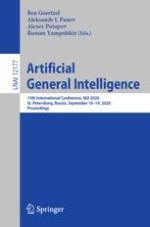2020 | OriginalPaper | Chapter
Post-turing Methodology: Breaking the Wall on the Way to Artificial General Intelligence
Author : Albert Efimov
Published in: Artificial General Intelligence
Publisher: Springer International Publishing
Activate our intelligent search to find suitable subject content or patents.
Select sections of text to find matching patents with Artificial Intelligence. powered by
Select sections of text to find additional relevant content using AI-assisted search. powered by
